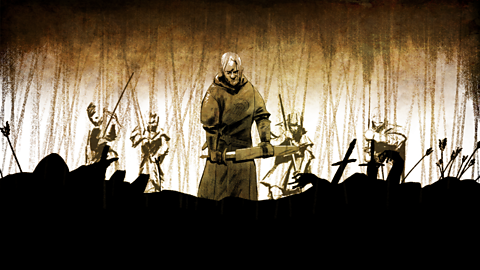Over the summer of 1066, the new King, Harold II, stationed his troops on the south coast of England. He had news of an impending invasion from William, Duke of Normandy, who was intent on deposing him. But strong, northerly winds prevented the Duke's army from sailing across the Channel. On 8th September, Harold disbanded his troops and returned to London. But those same northerly winds actually helped propel the fleet of another invasion - this time in the north of England from the King of Norway. Now it was up to King Harold to put a stop to this bid for the English throne.
Harold Godwinson had only been crowned king a few months earlier. He claimed that on his deathbed, King Edward the Confessor had named Harold heir to the throne. The Norwegian King, Harald Hardrada, was a giant of a man. His fearsome reputation earned him the nickname "the Thunderbolt of the North." He believed he should be king because of an alleged promise to his deceased father. Hardrada was supported in his ambition by Tostig Godwinson, the embittered brother of the King of England. Hardrada and Tostig had already defeated the northern English earls on September 20th at the Battle of Fulford. York had surrendered to them and they had been promised hostages in return.
As soon as King Harold heard of the Norwegian invasion, he gathered an army, raced north at lightning speed, mustering more troops as he went. All kings and noblemen had trained, professional soldiers called huscarls, who lived in their household and protected and defended them both in peace and war. The huscarls were supported by part-time soldiers, who made up a militia called the fyrd. They were recruited from every village in England and had to defend their local area and provide their own food and equipment.
On the afternoon of Monday 25th September, 1066, the English army arrived at a place known as Stamford Bridge. The King had travelled just under 300 kilometres in only five days. It was here that Hardrada and Tostig had set up camp. They were resting, celebrating their earlier victories and awaiting delivery of the hostages they'd been promised. Not expecting any trouble, they had left their armour behind at their ships 25 kilometres away, bringing only weapons, shields and helmets. Suddenly they noticed a huge army racing towards them. The Norwegians had been taken completely by surprise. The only thing that separated the Norwegian King from the English was the River Derwent, with just a narrow bridge and two nearby fords allowing access to the other side.
According to the Anglo-Saxon Chronicles, a ferocious, unarmoured Viking berserker held back the whole of the English army from crossing the bridge. He killed 40 English single-handedly, until a cunning soldier paddled under the bridge and thrust a spear through the wooden slats and into the axeman. Harold's army stampeded across the bridge. Hardrada sent three riders "on the fastest horses" to return to the fleet and fetch his reserve warriors. He then ordered his troops to create a defensive shield wall on top of the hill on the eastern side of the river. Harold's army, almost twice as large as Hardrada's, also formed a shield wall and advanced up the hill.
Before the main battle commenced, King Harold tried to persuade his brother Tostig to swap sides, offering to reinstate him as Earl of Northumbria. But when Tostig demanded to know what his ally Hardrada could have, the King spat, "Seven feet of land for a grave!" The battle began. The Norwegians were hopelessly outnumbered and their line began to break as the English advanced. Hardrada then moved forward, swinging weapons in both hands, despite having neither a shield nor long mail shirt for protection. But it was a bad move. Hardrada was struck in the throat by an arrow and killed. Tostig was also slain. As the last Norwegians fled, the reinforcements from the ships finally arrived, too late to save their king.
Florence of Worcester's account of the battle in the Anglo-Saxon Chronicles records how Hardrada's son Olav survived the fighting and gave himself up to the English king. But in an act of mercy, Harold allowed Olav to return to Norway with those who survived, providing they swore an oath of loyalty to him and promised never to invade again. Out of Hardrada's vast fleet of more than 300 ships, only 24 were needed to carry the survivors home. The Viking threat had been driven from England once and for all. Harold had won. But only two days later, the winds turned to the south, and as the sun went down, William, Duke of Normandy set sail for England.
Video summary
The Battle of Stamford Bridge was the second September battle in 1066, between King Harold of England and King Harald of Norway and Tostig.
The Anglo-Saxon army had marched all the way from London to Stamford Bridge - near York - in only five days, and managed to catch the invaders unprepared.
Harald and Tostig arrived in Northern England in 300 ships, but only 24 were needed to take the survivors, including Harald's son Olaf, home to Norway.
Two of the contenders for the throne were killed at Stamford Bridge, leaving only William in a position to challenge Harold Godwinson.
Teacher Notes
Key Stage 3:
Florence of Worcester is mentioned as writing an account of the Battle of Stamford Bridge in the Anglo-Saxon Chronicles. Students could look at how Florence of Worcester would know about the events at Stamford Bridge?
Key Stage 4:
Compare the Battle of Fulford with the Battle of Stamford Bridge. Are there any similarities you can find? What is the significance of the Battle of Stamford Bridge in the story of 1066?
This clip will be relevant for teaching History in secondary schools in the UK. This topic appears in OCR, Edexcel, AQA, WJEC KS4/GCSE in England and Wales, CCEA GCSE in Northern Ireland and SQA National 4/5 in Scotland.
1066: The claimants to the throne (1/6) video
Edward the Confessor died in January 1066 without a son or heir. Who would be chosen to be king?
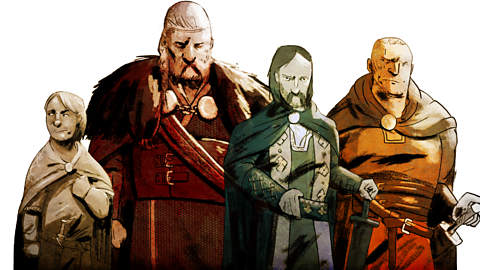
1066: The Battle of Fulford (2/6) video
In the first major battle of 1066, the Viking king of Norway, and Harold Godwinson's own brother Tostig, invade the north of England.
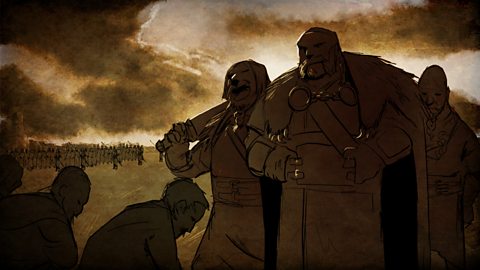
1066: The Battle of Hastings (4/6) video
William of Normandy arrives in Sussex for the decisive battle of the Norman Conquest.
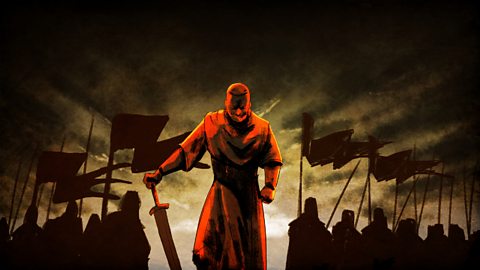
1066: King William and Domesday Book (5/6) video
How William the Conqueror secured control over England.
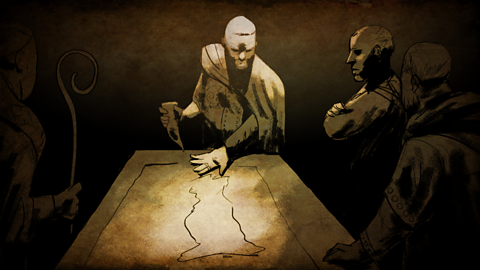
1066: Revolt and resistance (6/6) video
How did the Anglo-Saxons resist Norman rule after 1066?
